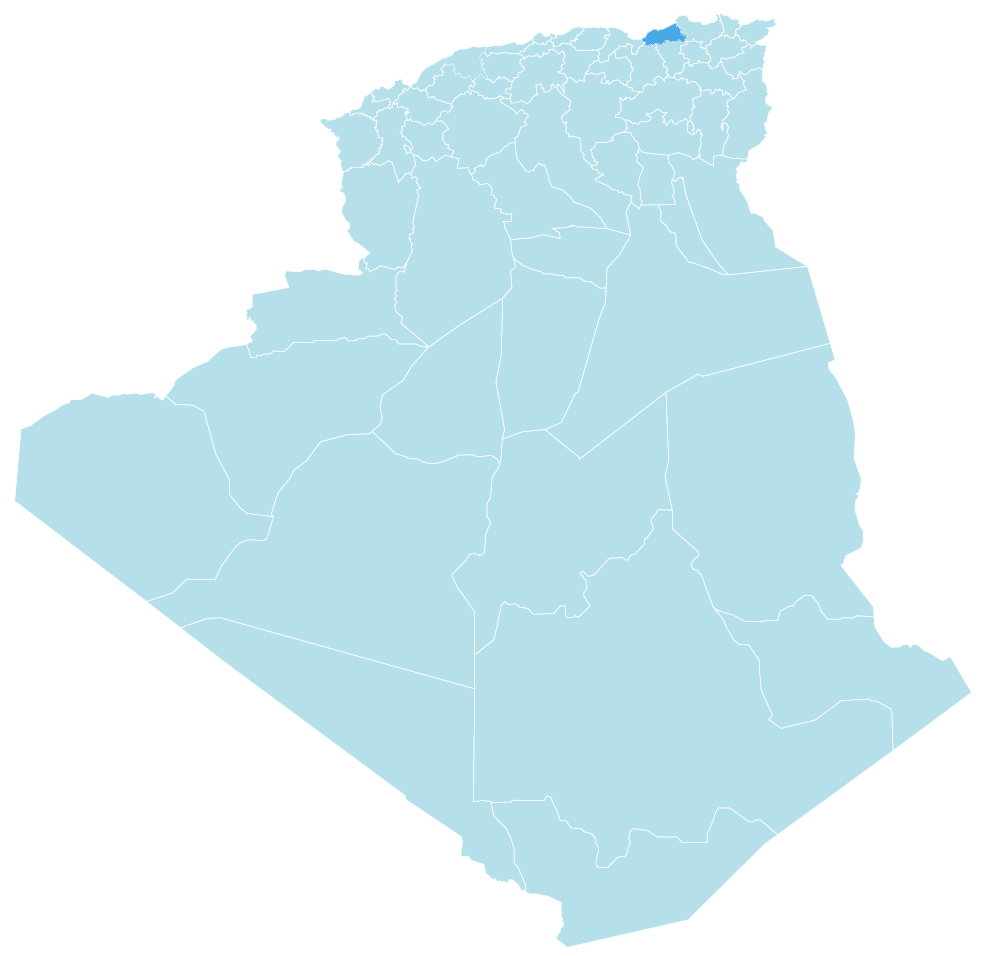The wilaya of Jijel occupies an important strategic location in the north-east of Algeria. It occupies an area of 2,398.63 km2, with a population of 736.201 according to 2016 statistics. It overlooks the Mediterranean Sea with a coastal strip of 120 km in length.
State limits:
- From the North: the Mediterranean.
- From the East: the wilaya of Skikda.
- From the West: the wilaya of Bejaia
- From the south: Setif and Mila.
Climate:
It is among the regions that know the largest rainfall in Algeria, as the annual precipitation rate is between 800 and 1 200 mm, and it has a Mediterranean climate, rainy and cold in winter with a temperature ranging between 05° and 15° and hot in summer with an average temperature of 25° and 35°.

- Jijel history:
The history of Jijel province goes back to prehistoric times, and this was indicated by the various remains and archaeological sites scattered across its territory, and archaeological research indicated a number of these sites, such as the site of Taza and Mazghitan, by foreign specialists and the Institute of Archeology in Algeria on the presence of primitive man since the stone ages. And who was able to form primitive civilizations, most of which date back to the Upper Stone Age, the Neolithic period, and the Ibero-Moroccan civilization, whose tools dated from 10 000 BC to 2 500 BC.
- Phoenician and Numidian period:
Most of the historical sources and documents confirm that the city of Jijel was of Phoenician origin, where the Phoenicians established a commercial port for their commercial exchanges. It means a circle of stone, and its full meaning is “the whirlpool beach” and the mixture between the Phoenician civilization and the local civilization, which is the Libyan civilization, led to the creation of a new type of civilization that distinguished the North African region, which was called “Punic or Punic civilization”, and the best evidence of This Punic cultural heritage is the site of the association in the municipality of Jijel, which is dated between the 06th century BC – 03 BC by studying the funerary furniture found in the tombs. During the Punic Wars that took place between Carthage and Rome, Igiljeli was part of Western Numidia, limited to the east by the Ampsaga River (present-day Guadalquivir) and its inhabitants were from the Masisil under the command of Syphax, and after the elimination of Carthage in the Battle of Zama (Third Punic War) The rule of Numidia passed to Massenissa, and Jijel was part of it.
- Roman period:
The disturbances provoked by Jugurtha facilitated the Roman invasion of the whole of Numidia, and thus Jijel was subjected to the Roman occupation during the reign of Emperor Octavius Augustus, and was placed as part of Caesarea Mauretania under the rule of Yuba II. During the year 22 AD, the uprising of the barbarian leader Takfarinas against the Romans, and their army was led by the commander Decorios, where the two armies met near the Bagida River (currently the Nile Valley), and In this battle, the commander Takfarinas was able to kill the Roman commander Decorios, and the year 24 AD knew the death of the leader Takfarinas in another battle against the Romans led by the Roman proconsul Dolabella. In the year 372 AD, the Roman commander Theodos landed at the port of Igilili in order to eliminate the revolt of the barbarian leader Fermus, and the Romans identified the inhabitants of the region under the name of Zenis due to the large number of revolutions against them. The Roman period in the region was also known for the establishment of several cities, some of which were of great importance in Roman rule, such as the city of Shuba Minicipium, founded by the Roman Emperor Octavius, and it was promoted to the rank of a Roman town “Municipium” by Emperor Hadrianus, and it had a role Large in trade exchanges between Rome and North Africa through its port.
- Vandal invasion:
During the 05th century AD and exactly the year 430 AD, Jijel was subjected to the Vandal invasion, and it was followed by the destruction and destruction of all regions of the Roman Empire.
- Byzantine period:
The Byzantines came to North Africa to restore the glory of the Roman Empire, where their armies set out from Constantinople (currently Istanbul), and landed first on the coasts of Tunisia in the year 335 AD. Carthage fell, then followed by other coastal cities, including Jijel, and during the Byzantine era, the Byzantines tried to build what the Vandals had destroyed. , as they preserved the Roman borders and roads, reconfigured them, established their fortresses, built cities, and continued in the region for a century.
- Islamic period:
The presence of the Muslim Arabs in the Maghreb dates back to the year 720 AD after the arrival of the Conqueror Musa bin Nusair to Ifriqiya (currently Tunisia), and then he was displaced by an army from Kairouan to the Jijel region in the year 772 AD, and thus Jijel became part of the Islamic rule and had great importance because it contained On two ports, the first is difficult to reach, and the second is called “Marsa Shara”, which means “Marsa Al-Souk”, according to what the historian Ibn Katheer mentioned. During the establishment of the Aghlabid state in Tunisia and its capital, Kairouan (882 AD), Jijel was a part of it, and it is known that the people of Jijel are from the Berber “Katama” tribe, and this tribe played an important role in the establishment of the Fatimid state during the 10th century AD, through It embraced the call of “Abdullah al-Shi’i”, where, starting from the south of the city, the call began and headed east and overthrew the majority state, then reached Egypt and built Cairo and took it as the capital of their caliphate and built the Al-Azhar Mosque (953 AD – 975 AD), which gave birth to Many Muslim scholars, and these historical events were mentioned in the book “Tuhfat Al-Ahbab” by Al-Sakhawi. During the era of the Hammadid Caliph “Al-Nasir Ibn Alnas” called “Alaa’ Al-Nas”, Jijel was under the authority of the Hammadid state and its capital was Bejaia.
- Norman and Genoese period:
In the year 1143 AD, the Normans (the peoples of Sicily) led by the Sicilian King “Roger II” invaded the city and destroyed it completely. And they remained in the city until the advent of the Almohad prince “Abd al-Mu’min” who eliminated the power of the Hammadids and imprisoned their king Yahya bin Abdul Aziz and seized the entire city and annexed it to his rule. Jijel has known many invasions during this stage. Starting in the year 1260 AD, the Genoese occupied the city and took it as a commercial port for their commercial exchanges. Great from the city.
- Ottoman Turkish period:
This stage begins in the year 1514 AD after Baba Aruj came to Jijel at the request of the people in order to rid them of Genoese domination. The residents called him “Sultan of Jijel”, where he settled and used it as a starting point to liberate the capital from the Spanish invasion in 1516 AD and eliminated its ruler, “Salim al-Toumi”. In the year 1518 AD, Baba Arouj died near Tlemcen. He was succeeded by his brother “Khair al-Din”, as he was more lenient with the people and worked to help Muslims fleeing from Spain. He died in 1547 AD in Constantinople (currently Istanbul). The residents of Jijel enjoyed a special status with the Turks, so that they did not pay taxes like other regions. During the 17th century AD, and exactly in July 1664 AD, the French King Louis 14 sent a military fleet led by the Duke “De Beaufort”, where this mission landed near the Sidi Ammar Mosque and was met with fierce resistance by the people, forcing them to withdraw on October 31, 1664, carrying many Human and material losses. And at the beginning of the 19th century AD, the revolution of Ahmed bin Al-Arash took place against “Bey Osman” Bey Constantine near the borders of Millia, and here the bey died after falling from his horse.
- French colonial period:
The French colonial attack on Jijel was on the morning of May 13, 1839 AD, with the arrival of a French mission from Skikda led by “Dossal” on board two warships “Sitex” and “Serber”. On May 15, they completed their defense system at the fortress of Saint-Eugene, on the top of Mount Ayuf. The French armies were met with strong resistance by the population and continued throughout the spring of 1839, after which the resistance moved to the top of the city after its retreat in the city center. After the French armies settled in the city, the region witnessed many popular revolutions to displace colonialism, including the Muqrani revolution in 1871, where the latter sent an army of 8,000 soldiers to attack the colonizer in various aspects of the region. The popular revolutions, which continued until the emergence of the national liberation revolution on the 1st of November 1954 AD, which resulted in the independence of the entire national territory, including the Jijel region.
The wilaya of Jijel province is administratively divised into 28 municipalities (communes), attached to 11 district
- Jijel district: includes the municipality ofJijel
- Djimla district: includes the municipalities of Djimla and Boudriaa Ben Yadjis
- El Ancer district: includes the municipalities of El Ancer, Bouraoui Belhadef, Djemaa Beni Habibi and Kheïri Oued Adjoul
- El Aouanna district: includes the municipalities of El Aouanna and selma Benziada
- El Milia district: includes the municipalities of El Milia and Ouled Yahia Khedrouche
- Chekfa district: includes the municipalities of Chekfa, El Kennar Nouchfi, Bordj Tahar and Sidi Abdelaziz
- Settara district: includes the municipalities of Settara and Ghebala
- Sidi Maarouf district: includes the municipalities of Sidi Maarouf and Ouled Rabah
- Taher district: includes the municipalities of Taher, Emir Abdelkader, Ouadjana, Chahna and Boucif Ouled Askeur
- Texenna district: includes the municipalities of Texenna and Kaous
- Ziama Mansouriah district: includes the municipalities of Ziama Mansouriah and Eraguene


